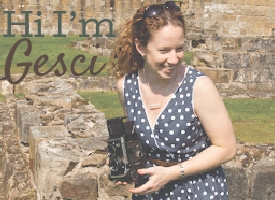The infamous entry to Birkenau. The weather the day of our tour was questionable, while rain in Poland is common our guide was concerned about lightning storms because there is no cover at Birkenau. We decided to chance it and not skip any parts of our tour, and we were in luck, as the weather held and we got to see as much as we could in one day.
The railtracks leading to the disembarking point, also the first selection.
One of the wooden bunkhouses. The first buildings at Birkenau were built with brick (you'll see them further down) but as the camp became rapidly and severely overcrowded (despite the large groups of people never given bunks) the prisoners labored to build wooden barracks. Many of these were burnt by the Nazis just prior to their fleeing the camp before the Soviets arrived, but a couple survived and some were rebuilt by survivors (willingly) after the war in order to stand as a witness to the horrors of the camp.
Guard house.
The latrines. Prisoners were allowed to go to the latrines twice daily and beaten for any other occasions, despite dysentery being rampant throughout the camp. The "toilets" only went as deep as you see here, perhaps a few inches further, which led to overflow and infection. There was no privacy, no toilet paper, no disinfectant, and no soap. Water in the sink troughs was infrequent.
A view through the fence of the burned wooden barracks. The standing chimneys are all that's left of these buildings. The camp was divided into sections that each had their own kitchen and gate. There was no movement between the sections.
This railcar was not actually from the camp, but is contemporary and has the modifications made by the Nazis. One significant modification is the hut on the back- a guard rode here, to shoot anyone who managed to escape the car during transport. This gravel area between the rail tracks is where prisoners were unloaded, families separated, belongings set aside, and the start of many victims' final moments.
A road between two sections, about 2/5 mile according to our guide. It was a rough cobbled walk with shoes, and being well fed and healthy.
A gate into one section. Prisoners who were "lucky" enough to be let out for work each day were accounted for as they exited and entered this gate.
The woods on the edge of Birkenau. These woods existed during the camp's time, there is actually a picture on site of some Jewish families enjoying a picnic here as they wait to be "processed"- into the gas chamber you can see crumbled in the background.
The first two gas chambers at the camp were pre-existing cottages the Nazis took over. These were called "The Little Red House" and "The Little White House". As these were deemed inefficient for the numbers of victims coming into the camp, larger gas chambers were built. The newer gas chambers were mostly underground, with undressing rooms in a smaller building above ground. This aided the Nazis deception of the true purpose of the camp. This gas chamber was destroyed by the Nazis prior to their evacuation of the camp in 1945. The pile of rubbled bricks is, to me, a poignant metaphor for the people previously piled in these rooms daily.
Another gas chamber, this one shows how the actual gassing rooms were underground. The SS guards put the Zyklon B in through holes in the roof.
Part of a memorial erected in the 1960s. There are plaques in all of the languages of the victims.
The gate between the gas chambers and crematorium, left as part of the memorial. There is one cobblestone for each victim.
The rubble of a crematorium.
Same rubble- just to show you how close they were to the barracks.
The older brick barracks.
One of the brick kitchens.
Because were were a small group (we hired a private guide, it was rather inexpensive and well worth it) we were able to see two buildings off limits to the general public. One, shown here, was the children's building. Used for non-Jewish children, it had some murals on the walls much like at Auschwitz. Otherwise the conditions were the same as the adults. The other building we were able to see was where women who were too sick to work or deemed unfit to go on were sent to wait their turn for the gas chambers. As the gas rooms were often overcrowded with incoming victims, the prisoners selected for death were often made to wait, sometimes up to two weeks. Once they were selected they were marked off the prison roster, so they no longer had any food or water allocations. Their bunks were narrower than these and often held more people. Anyone who died was piled outside to wait for the crematorium, sometimes for days.































No comments:
Post a Comment
Thanks so much for stopping by! I can't wait to read your comment!